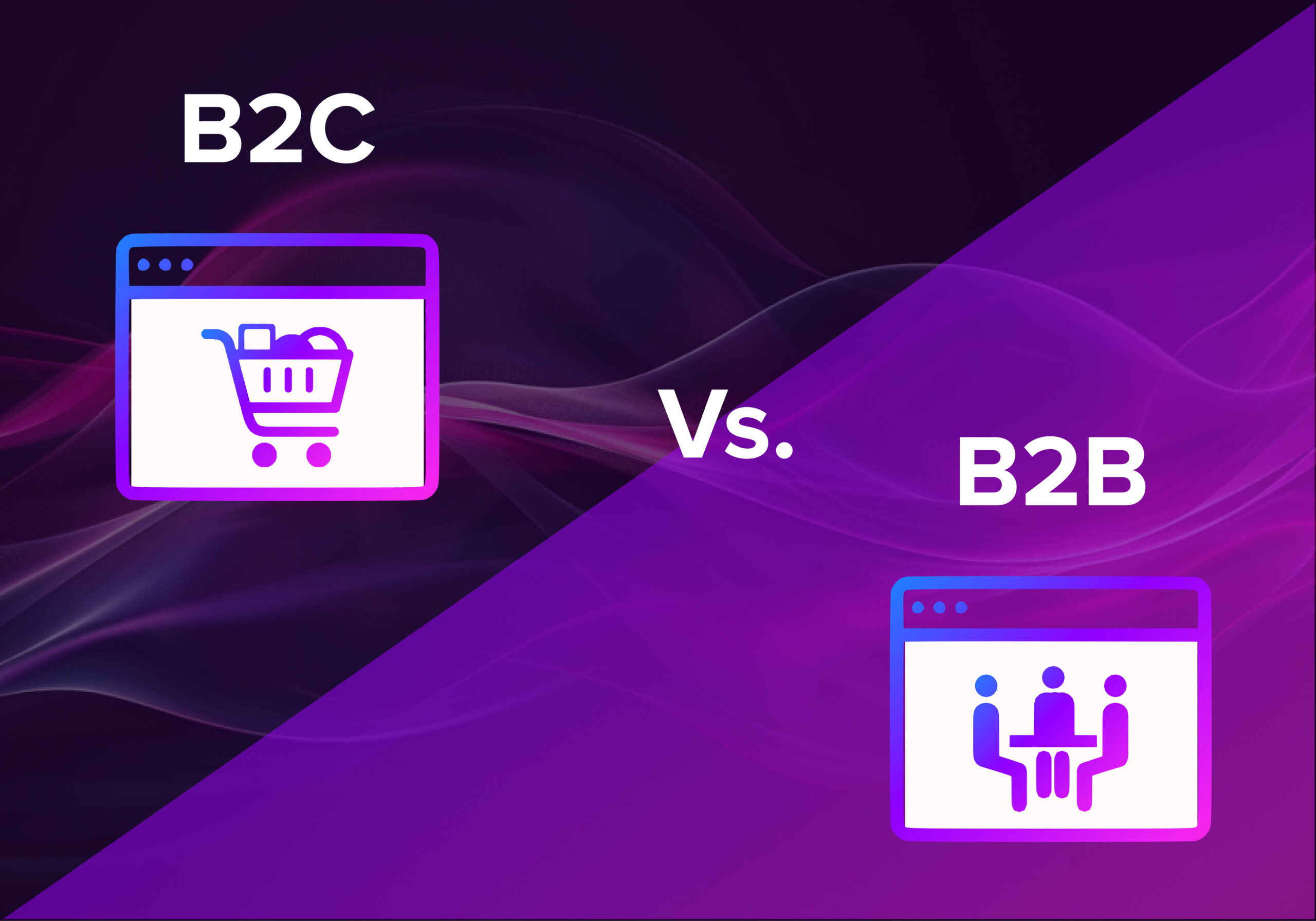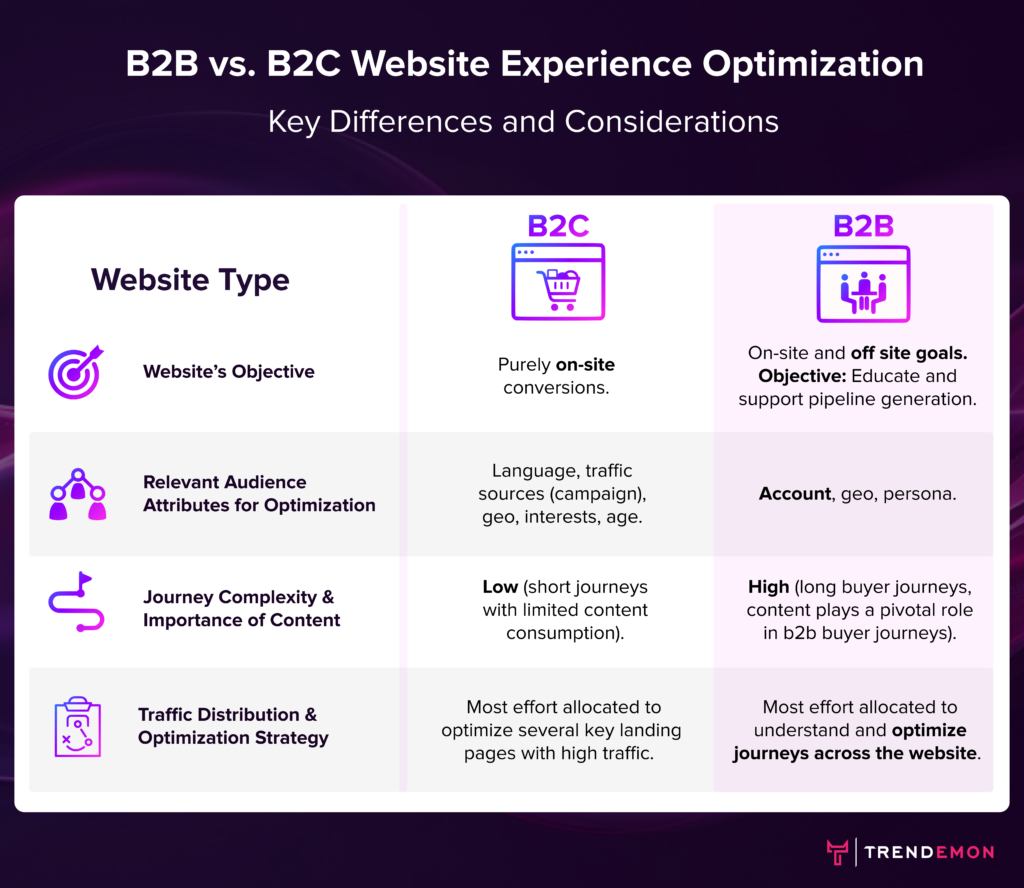Understanding the Differences Between B2B and B2C Websites

Here’s the thing about B2B and B2C websites:
They’re not just different—they’re designed for completely different worlds.
A B2B website focuses on business buyers who need in-depth information and logical decision-making. Meanwhile, a B2C website targets individual consumers, aiming for quick purchases and emotional engagement.
But here’s the kicker: understanding the difference between B2B and B2C websites isn’t just helpful—it’s essential. It’s the foundation of creating a site that works for your audience.
In this guide, we’re going to break it all down.
By the end, you’ll know exactly what makes these sites unique and how to optimize yours for success. Let’s dive in!
The difference between B2B and B2C website
B2B and B2C websites are tailored to serve distinct audiences with specific needs. B2B websites typically target other businesses and organizations as customers, focusing on features like account-based pricing and supporting long purchase decisions.
In contrast, B2C sites are generally designed to be accessed by individual consumers, prioritizing ease of use and quick transactions to suit their target market.
Target Audience
B2B websites cater to business buyers or B2B companies who are making strategic decisions. These users prioritize detailed product information, ROI, and long-term partnerships. In contrast, B2C websites target individual consumers, focusing on convenience and emotional connections.
Buying Behavior
B2B buyers tend to have longer sales cycles, with purchases involving research, comparisons, and multiple stakeholders. For B2C customers, the process is faster, often driven by impulse or immediate needs.
Decision-Making Process
The B2B decision-making process involves teams, approvals, and data-driven reasoning. In B2C businesses, decisions are typically made by a single person and are influenced by personal preferences.

Journey Complexity
In B2C, the goal is to have the shortest possible journey. Users often need to make quick decisions after visiting a few pages.
However, in B2B, the journey is much more complex, involving several pages read by multiple people from the same account.
B2B website optimization needs to facilitate the movement of visitors effectively between these pages, ensuring a smooth and engaging experience for all stakeholders involved.
Order Size and Frequency
B2B transactions involve larger, recurring orders, reflecting ongoing business needs. B2C purchases are smaller and more varied, aligning with the preferences of individual consumers.
Understanding these distinctions is critical for tailoring your website design to fit the unique demands of each audience.
Similarities Between B2B and B2C Websites
Here’s something surprising: despite their differences, B2B and B2C websites share some critical similarities.
Need for User-Friendly Design
Whether you’re selling to B2B buyers or B2C customers, one thing’s for sure: your website needs to be easy to navigate. A clean layout, intuitive menus, and fast-loading pages make the difference between keeping users engaged and losing them.
Example?
Both B2B companies like HubSpot and B2C brands like Amazon prioritize simplicity, ensuring users can find what they need quickly.
Importance of Mobile Optimization
This one’s non-negotiable. With more buyers—both business and consumer—using mobile devices, your website must look and perform great on smaller screens. Research from Google shows that mobile-friendly websites are more likely to convert visitors into buyers.
Security Considerations
Security isn’t optional. Both B2B transactions and B2C purchases involve sensitive data like payment details and personal information. Implementing SSL certificates, secure payment gateways, and user authentication is vital for building trust.
Bottom line?
No matter your audience, focusing on these similarities ensures a solid foundation for your website’s success.
Best Practices for Designing B2B Websites
Creating a great B2B website isn’t about flashy visuals—it’s about functionality and trust. Here’s what you need to nail:
Focus on Detailed Product Information
B2B buyers demand specifics. Include product specs, case studies, and downloadable resources like whitepapers to help buyers make informed decisions. Salesforce does this exceptionally well by offering in-depth solutions pages.
Simplify the Ordering Process
Streamline your B2B transaction process by minimizing clicks and creating intuitive workflows. Tools like HubSpot’s quoting feature make it easy for buyers to request and confirm pricing directly online.
Provide Self-Service Options
Modern B2B customers want autonomy. Add features like account dashboards and automated reordering to enhance the user experience. Think Amazon Business, where customers can manage bulk purchases seamlessly.
Best Practices for Designing B2C Websites
For B2C websites, it’s all about creating an emotional connection and reducing friction. Here’s how to do it right:
Streamline Checkout Process
A complicated checkout is a conversion killer. Use tools like Shopify’s one-click checkout to simplify the experience for B2C customers and minimize cart abandonment.
Use High-Quality Visuals
Visuals make a huge impact on B2C marketing. Use professional images and videos that highlight your products and services in action. Apple’s product pages are a prime example of this strategy in action.
Implement Personalized Recommendations
Leverage tools like Adobe Target or Shopify AI to show customers products tailored to their preferences. For instance, Netflix’s recommendation engine keeps users hooked by suggesting shows they’re likely to love.
Measuring Success: KPIs for B2B and B2C Websites
Knowing what’s working—and what’s not—is the key to improving your website’s performance. For B2B and B2C websites, tracking the right metrics is essential.
Metrics to Track
For B2B websites, focus on:
- Lead generation: Measure form submissions, demo requests, and email signups.
- Conversion rates: Track how many site visitors turn into qualified leads or buyers.
- Customer retention: Use metrics like customer lifetime value to gauge long-term success.
For B2C websites, prioritize:
- Cart abandonment rates: Identify how often users leave before completing a purchase.
- Average order value (AOV): Measure the profitability of each sale.
- Engagement metrics: Track time on site and bounce rates to assess user experience.
Tools for Analysis
Use Google Analytics for both B2B and B2C sites to monitor traffic and conversions. For detailed customer behavior, tools like Hotjar reveal where users click and what drives them away. CRMs like HubSpot or Salesforce provide deeper insights into customer interactions.
Differences in KPIs Between B2B and B2C
The difference between B2B and B2C websites lies in their goals. B2B metrics often center around nurturing leads and long-term relationships, while B2C KPIs focus on quick transactions and immediate satisfaction. For example, while B2B marketers prioritize lead quality, B2C companies are more concerned with sales volume.
Future Trends in B2B and B2C Websites
The digital landscape is constantly evolving, and B2B and B2C websites must adapt to stay ahead. Here are three trends shaping the future:
AI and Personalization
Artificial intelligence is redefining the customer journey. For B2B websites, AI tools like Salesforce Einstein deliver personalized recommendations and predict buyer behavior. On B2C sites, platforms like Shopify AI create tailored shopping experiences, offering products based on user preferences. The result? Enhanced engagement and higher conversions.
Voice Search Optimization
With the rise of voice assistants like Alexa and Google Assistant, optimizing for voice search is crucial. For example, both B2B marketers and B2C companies can target conversational keywords to capture queries like, “What’s the difference between B2B and B2C websites?” This ensures visibility in a voice-first world.
Omnichannel Experiences
Users expect seamless transitions between devices and platforms. B2B sites are integrating CRM tools like HubSpot to unify interactions across email, chat, and web. Meanwhile, B2C brands use solutions like Klaviyo to deliver consistent messaging across social media, apps, and websites.
Conclusion
The difference between B2B and B2C websites comes down to their audiences, buying behaviors, and goals.
B2B sites focus on business buyers with detailed information, longer sales cycles, and recurring orders. In contrast, B2C sites target individual consumers, emphasizing simplicity, emotional appeal, and quick purchases.
Tailoring your website to your target audience is essential. By understanding these differences and following best practices, you can create a site that drives engagement, conversions, and long-term success.
The bottom line?
A well-designed website isn’t just a digital presence—it’s a powerful tool to serve your audience and achieve your business goals.